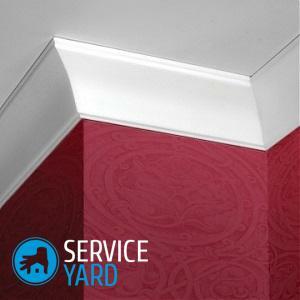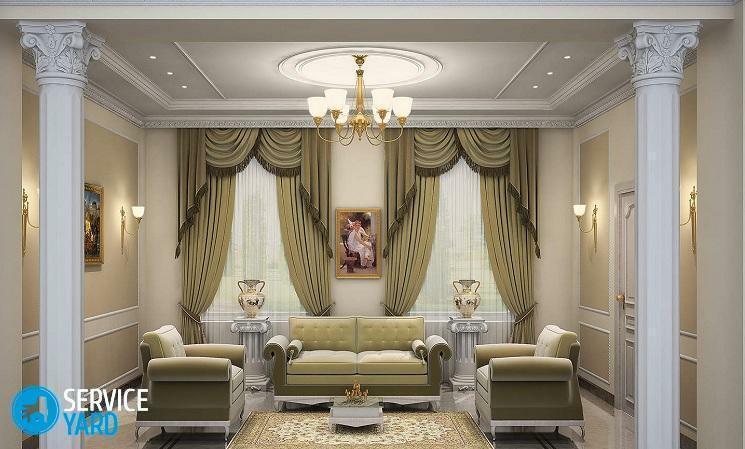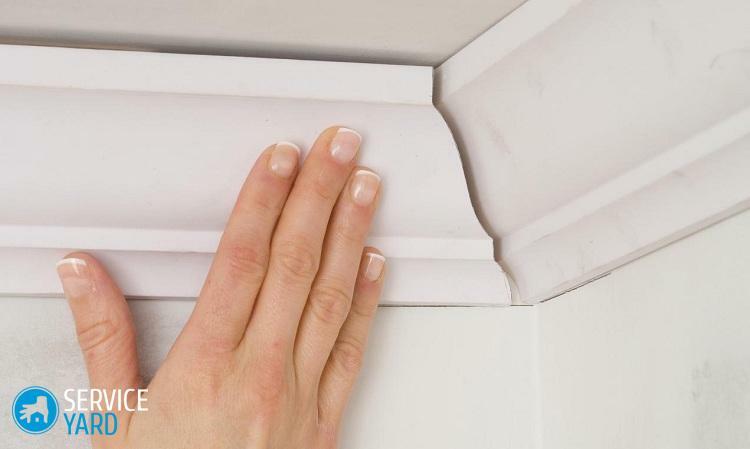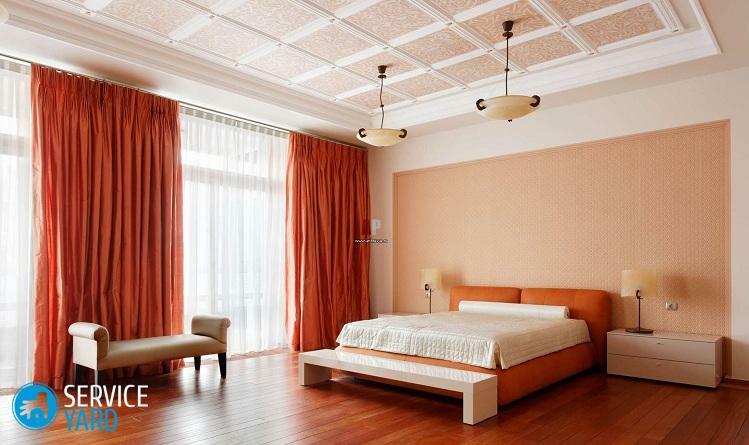
- Advantages of
- Types of ceiling skirting boards
- How to install ceiling skirting boards
- Installing skirting boards: steps
Bonding ceiling skirting is the final stage of repair. The process is not difficult and quite simple. Why do they mount such products? The fillets perform two important functions: practical and decorative. With the help of these materials, you can disguise minor defects in the junction of the wall and ceiling, as well as create a complete composition of the interior. Therefore, it will be useful to know what kinds of fillets are, and how to glue the polyurethane ceiling skirting.
to content ↑Advantages of
Ceiling baseboard is a building material in the form of a bar, its length can reach five meters. They can be made of wood, gypsum, polystyrene foam and polyurethane. Below we would like to elaborate on the latter version.
This type of skirting board is made of a strong, but at the same time, lightweight material, also called "foamed plastic".
What are the advantages of this type of finish? In fact, such skirting boards have a huge number of advantages:
- The material from which fillets are produced is absolutely harmless to health and is environmentally friendly.
- Longevity. The service life of skirting boards is almost thirty years. At the same time for such a long period they do not lose their presentable appearance.
- The products perfectly hide the flaws and irregularities of the ceiling with the wall. Some bars can even disguise wiring and other communications, for example, an Internet cable.
- Resistant to moisture, sunlight and various temperatures.
- Possibility of cleaning and care. Skirting boards can be treated with detergents.
Important! However, this does not apply to aggressive detergents, so before use, read the instructions of the cleaning agent.
- Elasticity of the material. The flexibility of the skirting board allows for quick and easy installation. It is this variety of fillets that are used for finishing surfaces with curvatures or projections.
- Beautiful decorative qualities. Skirting boards are suitable for interiors of various stylistic directions - from Classics to Modernity. Elements are produced in white, if desired - they can be painted.
- Representation and assortment. The abundance of fillet designs is enormous. You will be able to choose products in shape, size and decor.
- Skirting boards are lightweight, easy to handle, so installation will not be expensive.
As you can see, edging the joints of the ceiling and walls in the form of a polyurethane fillet is an ideal finish.
Important! The plinth has low impact resistance, that is, after a significant impact on its basis, dents may appear.
to the contents ↑Types of ceiling plinth
Before you decide how to glue the polyurethane ceiling skirting, let's still find out some of its types.
Types of plinth according to external design
So, the facial design can be classified as follows:
- Smooth surface of the plinth. Products of this type are the simplest, their main task is to hide corners. Also, they are distinguished by the lowest cost, because the decorative features of such panels are very modest.
Important! The main advantage of smooth skirtings is their least tendency to settle dust and pollution, as a result - caring for them is very simple.
- Shaped version. These products can already boast a more intricate configuration, which creates a nice appearance of the panels. The fillets are characterized by the laconic form.
Important! This type of skirting is the leading position among the analogs.
- Embossed surface of the plinth. This kind of fillet is already, in fact, an element of design and interior decor.
Important! Most often, the relief is similar to an elegant and luxurious plaster molding. Because of this, it is not advisable to use it in all interiors, but in the most appropriate styles. For example, Baroque, Empire or Classics.

Types of skirting boards for the purpose of
Another classification of products implies a difference in their purpose and distinguishes such types:
- Ceiling decorative. These are standard slats, which are designed for the decoration of joints. Their feature in the absence of operational load.
Important! Separately, we can distinguish models of skirting with an increased degree of elasticity, which are used for finishing curvilinear planes.
- Ceiling for lighting. First of all, this type of plinth is a very original and stylish decoration of the interior. The configuration of these fillets is different than that of traditional slats: along the entire length of the product, there may be special gutters for the installation of an LED strip, or there are holes for installing built-in lighting fixtures.
Parameters skirtings
Well, we note, a couple of characteristics of polyurethane ceiling skirting. They are separated by the angle of the bevel on the front side, which can be:
- 30 degrees.
- 45 degrees.
- 60 degrees.
Another important parameter of the plinth is its width. There are three types of fillets:
- Narrow. The width of such products is in the range of 10-50 mm. Their use is advisable in rooms with low ceilings. The laconic narrow bar looks very stylish in such rooms.
- Medium. The width of these skirting boards varies between 60-150 mm. These products are best suited for most apartments and houses, as the optimal ceiling height for them is 2.5-2.7 m.
- Wide. Their width is 160-350 mm. Such volumetric elements are suitable only for the decoration of spacious rooms with high ceilings of more than three meters.
How to install the ceiling skirting boards
After choosing a particular product, it's time to ask the following question: what should the ceiling plinth be made of polyurethane? There are several options, and we'll talk about each of them.
Filler
If you ask professional cladders than to glue a polyurethane ceiling skirting board? The answer is - of course, putty. In the process of repair, the mixture is likely to remain in a small amount, and it is not difficult to work with it.
Advantages of using putty for installing skirting boards:
- It is not necessary to press the fillets for a long time to the surface and wait until they come to grips with it.
- During the installation with the aid of a mixture, it is possible to level the joints by covering various cracks and crevices.
- Reliable material that firmly holds the straps.
Adhesive and its types
It is logical that for gluing skirtings there are also suitable adhesive compounds. Glue for polyurethane foam ceiling skirting is divided into the following types:
- Polymer compositions. It is based on chemical solvents, so during the use of the adhesive spreads a characteristic sharp odor. It will disappear when the composition is completely dry.
Important! The main properties of polymer glue are high strength and moisture resistance.
- Acrylic. This type of glue has no odor, and produce it on the basis of water. Therefore, it can not be categorically used in rooms with significant humidity.
Choose one or another kind of need, based on the purpose of the room: for children use acrylic adhesive, and for the bathroom and kitchen - polymer.
Important! The most popular brands of glue for ceiling skirting boards made of polyurethane are "Titan" and "Moment".
The advantages in their favor are:
- Excellent astringent base.
- Durability and reliability.
- Speed of action.

Liquid Nails
Ceiling baseboards of polyurethane: how to glue on "liquid nails"?First of all, we note that this type of construction adhesive is applicable for a wide variety of materials. The composition is able to perfectly hold the ceiling fillets for many years.
There are two types of "liquid nails":
- Neopropropylene. The basis for manufacturing is an organic solvent, so the glue has a sharp odor, which is weathered after it is completely dried. Until then, this adhesive should be used with some caution and observance of safety measures. Especially good these "liquid nails" have proved themselves in conditions of high humidity.
- Acrylic. This type of retention agent is the safest and almost harmless. But they are suitable only for dry rooms.
Installing the skirting boards: the steps of the
action Before installing the products, determine the perimeter of the room, from which, calculate the number of slats. Depending on the size of the room, choose the appropriate width of the plinth.
Important! The style of the interior also imposes some peculiarities on the choice of a baguette: for patterned walls choose laconic smooth models, to a monophonic finish - more ornate.
Now we turn to the question of how to glue the polyurethane ceiling skirting step by step.
Stage 1: Surface preparation
Of course, you can not start the installation without preliminary machining of the planes. Places of gluing of decorative strips are prepared in such a way:
- We put the plinth to the place of its installation, we put the marks indicating the bottom edge of the product.
- Through the building level, we draw an even line that marks the place of gluing the plinth.
- It is for this strip that we remove the previous finish, if any, before the plaster layer or the concrete wall base.
Important! If you dismantle the trim a bit less with a margin of 1-2 mm, then avoid the formation of a gap in the future.
- After complete cleaning of the walls from the finish, we cover the surface with a penetrating primer. This composition can be replaced with a light adhesive solution or warm ordinary water, but it is better not to experiment.
- We are waiting for complete drying.
Step 2: Fitting the
material Before gluing the polyurethane ceiling skirting, it is necessary to adjust it to the appropriate dimensions. We recommend doing this:
- The most difficult and important docking is the combination of skirting in the corners. For these purposes, you will need a special tool for ceiling baguettes - hand stool.
- Plinth put in the chair in the position in which it will be installed. Then press firmly enough, cut at the required angle.
Important! Cutting is best done with a saw for this type of material or with a very sharp paint knife.
- Before plastering, it is necessary to attach plinths to each other to avoid gaps. If any, then the adjustment is carried out until the parts are completely joined, cutting off the excess material.

Stage 3: Direct mounting to walls and ceiling
The installation process can be described as follows:
- Determine what to glue the ceiling skirting of polyurethane. Above we have already considered the possible options, now you will use a specific one. Most often, special glue is used for these purposes.
Important! Before applying the adhesive, be sure to read the instructions to avoid possible reactions with polyurethane.
- Begin to apply glue on one of the skirting boards, which will be located in the corner.
- Then apply it to the surface of the wall, carefully align and press down as tightly as possible. Hold the bar necessary until the moment you do not make sure that the glue "grabbed".
Important! If excess adhesive is added during installation, remove them with a clean cloth or sponge. Do it better at once, so that the traces do not remain in the form of spots on the skirt itself.
- In the same way, glue the rest of the panel.
Important! For an excellent docking of skirting boards between each other, we advise you to apply a neat layer of glue on their ends. If the composition slightly protrudes, again, remove it with a clean rag.
Stage 4: Finishing of skirting board
This stage can not be called obligatory, as most often the processing of the plinth after its installation is not required. But there are cases when the modification of the external appearance of the baguette is necessary, based on the requirements of the interior.
In this case, we perform the following actions:
- The slots that are between the elements are sealed with acrylic sealant.
- Through the entire length of the skirting we glue the paint tape on the surface of the wall and ceiling. He will protect them from traces of paint.
- Apply to the skirting the paint of the desired color.
Important! For polyurethane skirting, the optimal type of paint is a mixture based on acrylic or latex. The application of the dye can be done with a brush or spray.
- When the paint dries, remove the paint tape. Your updated plinth is ready.
Here, perhaps, and all you need to know about how to glue a polyurethane ceiling skirting. I would like to note that this process is very simple, it is easy to implement with your own hands. And the range of skirting will make it possible to realize the brightest and original ideas, as a result - the interior of your house will become more elegant and individual.
